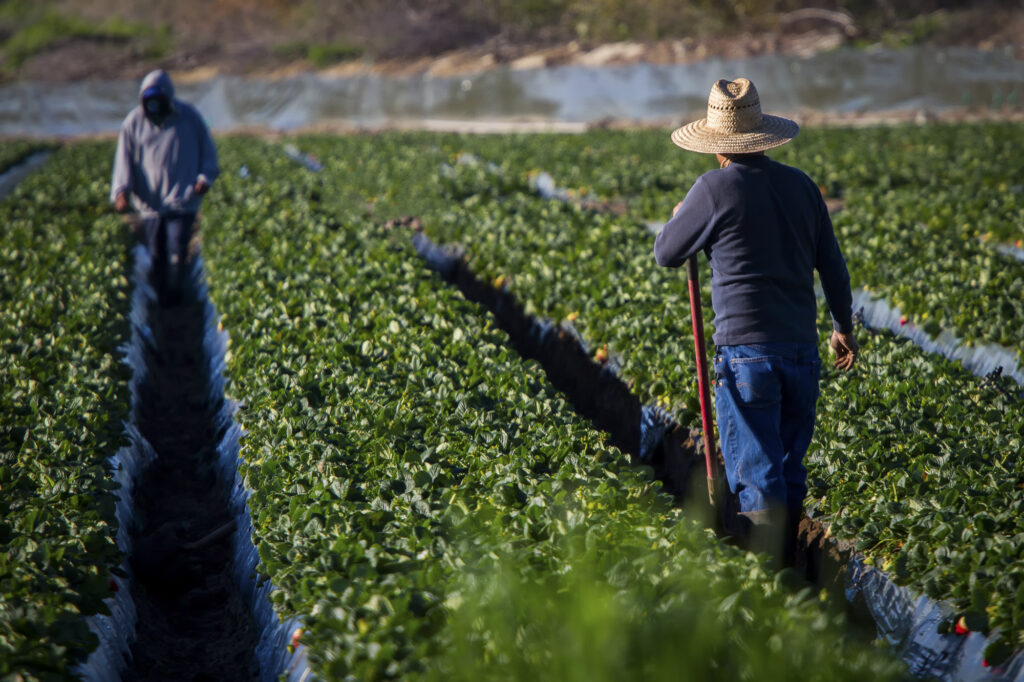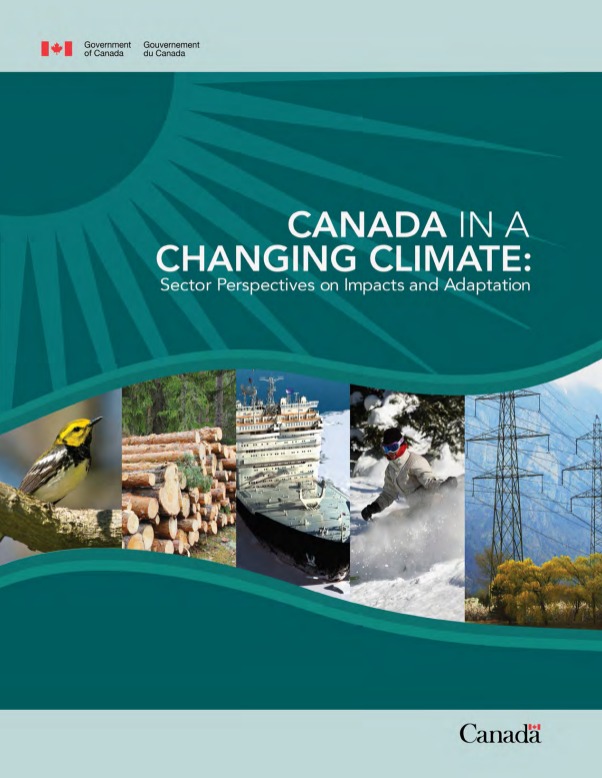What information is available to help?
There are many great resources that can help members of the farming community gain a deeper understanding of the potential impacts of climate change on agriculture.
1. ClimateData.ca – Agriculture Sector Module
On ClimateData.ca, users can explore different greenhouse gas emissions scenarios and access a range of agriculture-related climate variables. These variables can provide valuable insights into the potential impacts of climate change on agriculture and help inform farm management decision-making. The Agriculture Sector module includes links to important agriculture related variables such as:
- First fall frost: The first fall frost is an important milestone for frost-sensitive crops and plants. It marks the approximate end of the growing season. This variable can be useful for farmers as it demonstrates how climate change may affect the length of the growing season.
- Standardized precipitation evapotranspiration index (SPEI): SPEI is a drought index that compares precipitation and potential evapotranspiration. Negative values indicate a water deficit (higher drought risk!), while positive values indicate a water surplus (lower drought risk!). This information can be useful for farmers to help them predict potential future drought risk.
- Growing degree-days (GDD): GDD are a measure of the warmth of the climate (using a threshold temperature). GDD can be used to determine if conditions are suitable for plant and insect growth. Farmers can use this to help them choose the most suitable crops for their location, and plan their planting and harvest schedules accordingly. It can also help farmers to monitor and manage pests and diseases that may be more common in warmer conditions.
2. Agriculture and Agri-food Canada: Drought Watch and Agroclimate
Monitoring and forecasting in the near term are just as important as long-term planning. Agriculture in Canada is highly impacted by and dependent on weather and climate, and extreme events can result in significant losses. Agriculture and Agri-Food Canada (AAFC) is leading on climate and agriculture related work by developing and delivering tools and information to monitor the impacts of weather and climate on agriculture.
Information on weather and drought-related conditions for the agriculture sector is available on AAFC’s “Drought Watch and Agroclimate” page. These products focus on current weather and climate conditions in real-time and near-term forecasting, as opposed to the other longer-term forecasting and projection products listed in this article. The tools from AAFC have timescales that range from current, future (weekly, bi-weekly, monthly, and seasonal), as well as historical (up to 30-year averages). These wide ranges of timescales can help the agriculture sector plan and make informed decisions for the season. Near-term conditions and trends are also vital for the agriculture sector because monitoring and early warnings are key to understanding risk and potential impacts of weather and climate. Most of the products included on the Drought Watch and Agroclimate page are based on recent observed data.
In contrast, the long-term climate projections on ClimateData.ca are produced by climate models and simulate what the climate system may look like in the coming decades up to the end of the century. These projections use different emission scenarios to help us consider the potential different futures we may experience over the next decades depending on the choices we make in the coming years. You can learn more about Understanding Future Projections in the Learning Zone.
The tools available on the Drought Watch and Agroclimate page include:
Agroclimate conditions
Impact assessment
Forecasted conditions
- Canadian Crop Metrics: Forecasted drought severity and extent. This application allows users to examine in-season weather, satellite-based and risk data impacting crop yields alongside historical and forecasted crop yields
- Extreme Weather Indices: Extreme weather conditions used to predict agriculture risk
- Canadian Drought Outlook: Forecasted drought severity and extent
The NAIS Daily Weather Station Table from the National Agroclimate Information Service (NAIS) is also available through the Open Government Portal. This dataset uses weather and climate data from stations across Canada to show near-current conditions which can then be compared against historical averages to provide further context on the near-current conditions.
To learn more about these products visit Drought Watch and Agroclimate.
3. Climate Atlas of Canada – Agriculture Topics
The Climate Atlas of Canada is a valuable resource for farmers interested in understanding how climate change may affect agriculture. The agriculture section of the Atlas includes videos that explore different topics related to this sector. Below are some example:
- “Bad News in the Fields: Farmers struggle with erratic weather” is about farmers in the Prairie Provinces struggling with erratic weather patterns that make it difficult to harvest crops and require adapting farming practices.
- “Biogas and Biochar: Offsetting emissions from agriculture” explains how agriculture is responsible for 8% of Canada’s greenhouse gas emissions, but that the sector has the potential to offset some of these emissions through the conversion of manure and other agricultural waste products into biogas and biochar. Biogas can be used to offset fossil fuel usage, and biochar can be used to improve soil health and fertility.
- “Farming Carbon: Environmentally responsible ranching” shows how livestock producers in southwestern Manitoba are using rotational grazing to raise more cattle on less land, restoring the soil and sequestering carbon from the atmosphere in the process. This demonstrates that animal agriculture can be an important part of the climate solution.
In addition to the videos, the Climate Atlas of Canada also includes a variety of articles that touch on agriculture and climate change. These articles can provide further depth and detail on specific topics and can be a helpful resource for farmers looking to learn more about how climate change may affect their business.

4. Regional Climate Service Providers – ClimateWest
ClimateWest is an organization that works to provide resources and support to communities, businesses, non-profits and governments in the provinces of Alberta, Saskatchewan, and Manitoba as they adapt to and thrive in the face of a changing climate. They aim to identify current information gaps related to the region’s changing climate and agricultural production capacity. ClimateWest works with partners such as industry associations and government to share information, offer training and champion climate adaptation efforts in the agriculture sector. ClimateWest’s partners, including the Prairie Adaptation Research Collaborative, the Prairie Climate Centre, and the International Institute on Sustainable Development, have made significant contributions to understanding and addressing the impacts of climate change on agriculture in the region.
Check out https://climatewest.ca/sectors/agriculture/ for a list of reports and products relevant to agriculture.
6. The Map of Adaptation Actions
The Map of Adaptation Actions is a tool that allows users to search for and explore examples from communities and sectors in Canada that are adapting to a changing climate. It provides information on the steps that these groups are taking to understand and address the impacts of climate change on their operations and the solutions that they have implemented to increase their resilience. Users can browse through the agriculture related examples displayed on the map to learn about the adaptation efforts that are being undertaken by agricultural communities and businesses across Canada.
The examples provide detailed information on the challenges these groups are facing, the strategies they have implemented to adapt to a changing climate, and the outcomes and benefits of these efforts. Users can use the Map of Adaptation Actions to gain insights and ideas for their own adaptation efforts, as well as to learn about the broader trends and issues related to climate adaptation in the agricultural sector in Canada.

Contact Us
The Climate Services Support Desk is here to help Canadians find the information they need to better understand how climate change may affect their lives and communities. Whether you have questions about specific data or science related to climate change, or you’re looking for information on how to adapt to changing weather patterns and environmental conditions, the Support Desk is here to help. The Support Desk can help you with finding resources, understanding technical information, or just answering general questions about climate change.
If you’re not sure where to start or if you have specific questions, we encourage you to reach out to the Support Desk directly through the “Have a question?” button at the top of the page, and one of our trained professionals will be happy to assist you.













